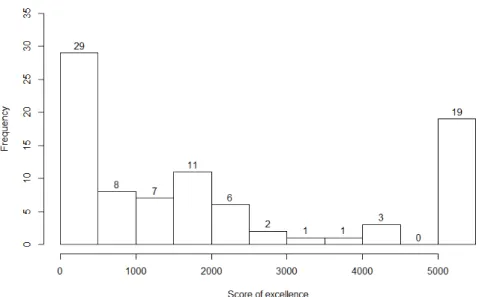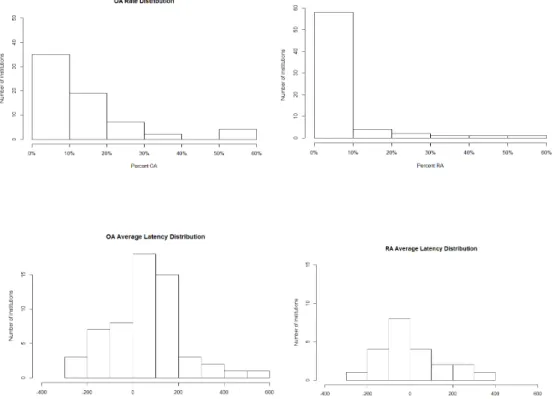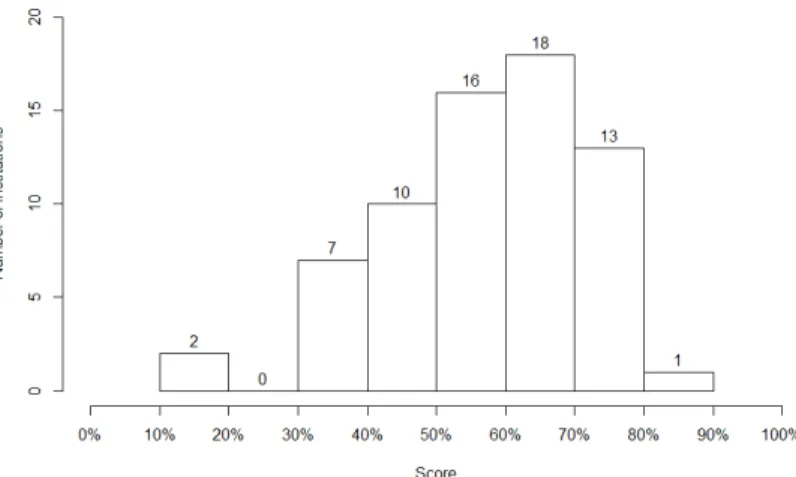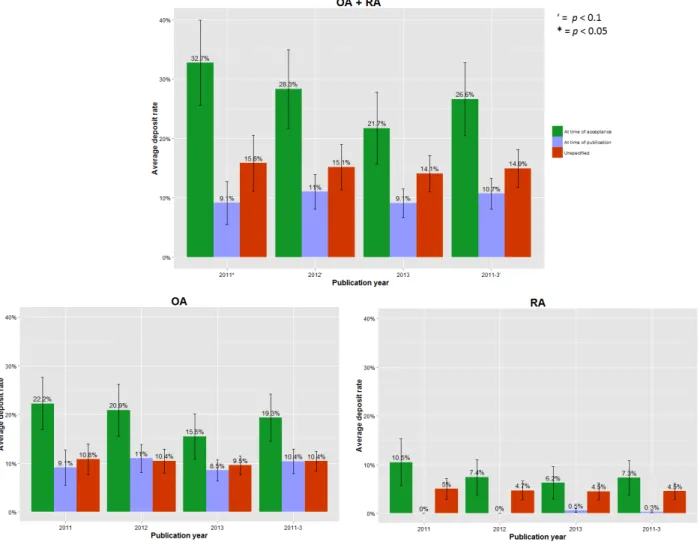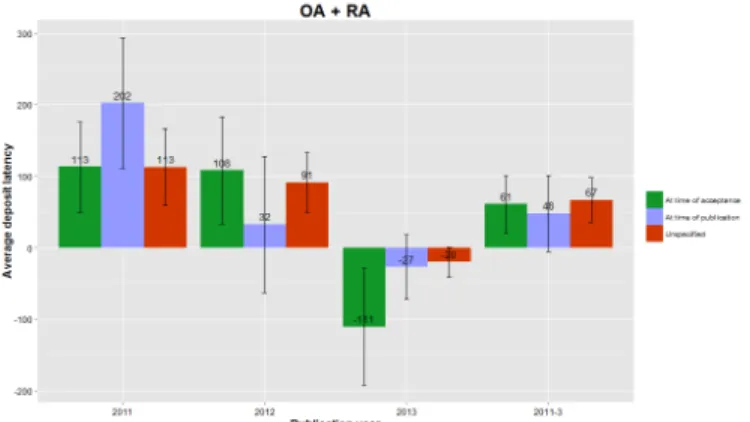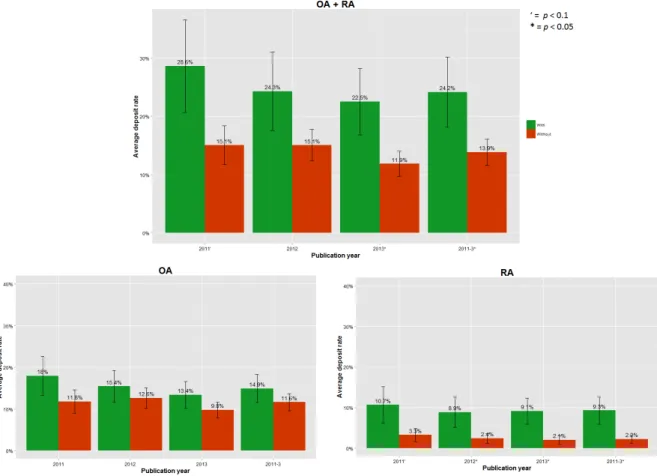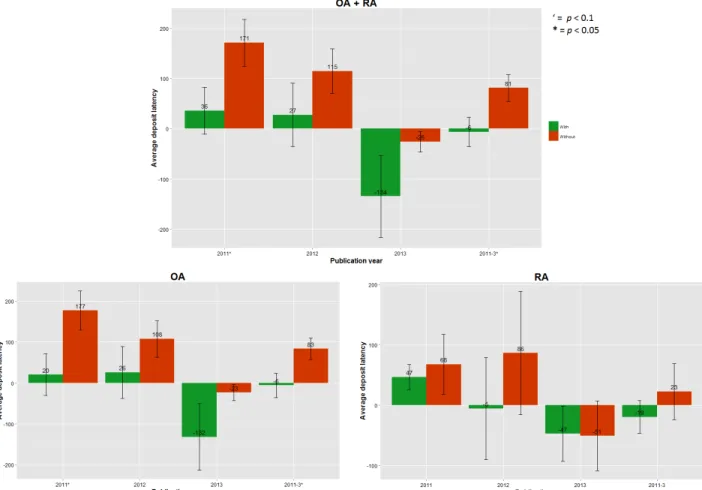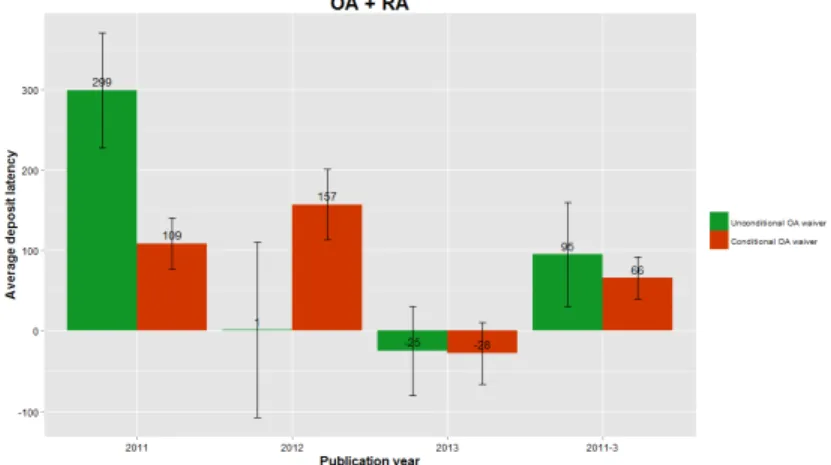Estimating Open Access Mandate Effectiveness: I. The MELIBEA Score
Philippe Vincent-Lamarre1,4, Jade Boivin1, Yassine Gargouri1,
Vincent Larivière2, Stevan Harnad1,3
1Université du Québec à Montréal, 2Université de Montréal, 3University of Southampton, 4Université
d’Ottawa
Abstract: MELIBEA is a Spanish database that uses a composite formula with eight weighted conditions to estimate the effectiveness of Open Access mandates (registered
in ROARMAP). We analyzed 68 mandated institutions for publication years 2011-2013 to
determine how well the MELIBEA score and its individual conditions predict what
percentage of published articles indexed by Web of Knowledge is deposited in each
institution’s OA repository, and when. We found a small but significant positive
correlation (0.18) between MELIBEA score and deposit percentage. We also found that for three of the eight MELIBEA conditions (deposit timing, internal use, and opt-outs), one value of each was strongly associated with deposit percentage or deposit latency (immediate deposit required, deposit required for performance evaluation, unconditional opt-out allowed for the OA requirement but no opt-out for deposit requirement). When we updated the initial values and weights of the MELIBEA formula for mandate
effectiveness to reflect the empirical association we had found, the score’s predictive power doubled (.36). There are not yet enough OA mandates to test further mandate conditions that might contribute to mandate effectiveness, but these findings already suggest that it would be useful for future mandates to adopt these three conditions so as to maximize their effectiveness, and thereby the growth of OA.
Introduction
The Open Access (OA) movement (BOAI 2002) arose as a result of two concurrent developments: (1) the “serials crisis,” which made research journals increasingly
unaffordable, hence inaccessible, to researchers’ institutions (Okerson et al 1995; Miller et al 2010), even the richest ones (Harvard University Library 2012) and (2) the advent of the online medium, which made it possible in principle to make all research journal articles freely accessible to all users online.
The primary target content of OA is refereed research journal articles, and that is the only kind of item analyzed in this study. Researchers can provide OA to their journal articles in two different ways – by publishing in an OA journal (“Gold OA,” often for a publication fee) or by publishing in a subscription journal and, in addition, self-archiving the final, peer-reviewed draft online (“Green OA”) (Harnad et al 2004). OA also comes in two degrees: “Gratis” OA is free online access. “Libre” OA is free online access plus certain re-use rights (Suber 2008). We will only be considering Gratis OA in this study, because Gratis OA is (i) a prerequisite for Libre OA, (ii) faces fewer publisher
considering Green OA (self-archiving), because (i) the majority of OA to date is Green, (ii) it does not entail any payment of fees, (iii) it can be provided by researchers
themselves, and, as will be explained below, (iv) providing Green OA can be mandated by researchers’ institutions and funders (without having to pay any extra fees).
One might have expected that because of the many advantages provided by OA (Hitchcock 2013) – free access for all users, enhanced research uptake and impact, relief from the serials crisis, and the speed and power of the online medium –
researchers would all have hastened to make their papers (Green) OA ever since it became possible. But the growth of OA – possible since even before the birth of the Web in 1989 (Berners-Lee 1989) -- has actually been surprisingly slow: For example, in 2009, already two decades after the Web began, Björk et al estimated the percentage of OA to be only 20.4% (the majority of it Green). In 2013 Archambault announced close to 50% OA, but Chen (2014) found only 37.8% and Khabsa & Giles (2014) even less (24%). All these studies reported great variation across fields and none took timing
adequately into account (publication date vs. OA date): Björk et al (2014) pointed out
that 62% of journals endorse immediate Green OA self-archiving by their authors, 4% impose a 6-month embargo, and 13% impose a 12-month embargo; so at least 79% of articles published in any recent year could already have been OA within 12 months of their date of publication via Green OA alone, 62% of them immediately, if authors were actually providing it.
There are many reasons why researchers have been so slow to provide Green OA even though they themselves would be its biggest potential beneficiaries (Harnad 2006). The three principal reasons are that (i) researchers are unsure whether they have the legal right to self-archive, (ii) they fear that it might put their paper’s acceptance for
publication at risk and (iii) they believe that self-archiving may be a lot of work. All these concerns are groundless but it has become increasingly clear with time that merely pointing out how and why they are groundless is not enough to induce authors to go ahead and self-archive of their own accord. Researchers’ funders and institutions worldwide are beginning to realize that they need to extend their existing “publish or perish” mandates so as to make it mandatory to provide OA to researchers’
publications, not only for the benefit of (i) the researchers themselves and of (ii) research progress, but also to maximize the (iii) return to the tax-paying public on its investment in funding the research.
Funders and institutions are accordingly beginning to adopt OA policies: Starting with NIH in the US and the Wellcome Trust in the UK -- soon followed by the Research Funding Councils UK, the European Commission, and now President Obama’s
Directive to all the major US federal funding agencies -- research funders the world over are beginning to mandate OA (ROARMAP 2014). In addition, research institutions, the providers of the research, are doing likewise, with Harvard, MIT, University College London and ETH Zurich among the vanguard, adopting OA mandates of their own that
require all their journal article output, across all disciplines, funded and unfunded, to be deposited in their institutional OA repositories.
These first OA mandates, however, differ widely, both in their specific requirements and in their resultant success in generating OA. Some mandates generate deposit rates of over 80%, whereas others are doing no better than the global baseline for spontaneous (un-mandated) self-archiving (Gargouri et al 2013). As mandate adoption grows
worldwide, it is therefore important to analyze the existing mandates to determine which conditions are essential to making a mandate effective.
We have accordingly analyzed the institutional mandates indexed by MELIBEA, a Spanish database that classifies OA mandates in terms of their specific conditions as well as providing a score for overall mandate strength. This score is based on a composite formula initialized with a-priori values and weights for eight conditions that MELIBEA hypothesizes to be predictive of mandate effectiveness (see Figure 3 and Table 1). The purpose of our study was (i) to test the predictive power of the overall MELIBEA score for mandate strength in terms of deposit rate and deposit timing, (ii) to test individually the association of each of the conditions with deposit rate and timing, and (iii) to update the initialized values and weights of the MELIBEA formula to reflect the empirical findings of (ii).
What we found was a small but significant positive correlation between MELIBEA score and deposit rate. We also found that for three of the eight MELIBEA conditions (deposit timing, internal use, and opt-outs), one of their values was most associated with deposit rate and latency (immediate deposit required, deposit required for performance
evaluation, unconditional opt-out allowed for the OA requirement but no opt-out for deposit requirement). When we updated the initial values and weights of the MELIBEA formula for mandate strength to reflect this association, the score’s predictive power was doubled. This suggests that it would be useful to adopt OA mandates with these conditions in order to maximize their effectiveness, and thereby the growth of OA. Databases Used
The data for our analysis were drawn from several databases. The ROAR Registry of
OA Repositories provided a database of all open access repositories (ROAR,
http://roar.eprints.org). The ROARMAP Registry of OA Repository Mandatory Archiving
Policies provided the subset of the ROAR repositories that had an OA mandate
(ROARMAP, http://roarmap.eprints.org). An in-house version of Thomson Reuters Web
of Science (WoS) database hosted at the Observatoire des sciences et des
technologies (OST-UQAM) provided the bibliographic metadata for all (WoS-indexed)
articles published in years 2011-2013 by any author affiliated with the ROARMAP subset of institutions with OA mandates that had been adopted by 2011. The MELIBEA
Directory and Estimator of OA Policies provided a classification of the OA mandates in
terms of their specific conditions (assigning a numerical value to each option for each condition) plus an overall score based on a weighted combination of eight of those
conditions as an estimate of mandate strength (MELIBEA (http://accesoabierto.net/politicas) (Table 1).
WoS indexes the 12,000 most cited peer-reviewed academic journals in each research area. (This corresponds to slightly more than 11% of the 105,000 peer-reviewed
journals listed in Ulrich’s Global Serials Directory, http://ulrichsweb.com.) We also used the Webometrics Ranking Web of Universities, which estimates institutions’ “excellence” based on how many of their published articles are among the top 10% most cited
articles (the lower the score the higher the rank). (http://webometrics.info). We excluded the bottom 19 institutions from our sample as outliers (i.e., those with Webometrics ranks beyond 5000th; see Figure 1). To balance representativeness and sample size, we also excluded institutions that had fewer than 30 publications during the 2011-13 time window under study. This yielded 68 institutional mandates for analysis.
Figure 1: Distribution of mandated institutions according to Webometrics “excellence” ranking based on citedness (lower score means higher rank).
Deposit Rate and Deposit Latency
Each of the 68 institutional repositories was crawled to determine what percentage of its WoS-indexed articles had been deposited (deposit rate), and when they were deposited (deposit latency, i.e., the delay between publication date, estimated by WoS indexation date, and deposit date) for publication years 2011, 2012 and 2013 (crawled in April 2014). Deposits could be of two kinds: Open Access (OA) or Restricted Access (RA), to
comply with publisher OA embargoes. We subtracted publication date from deposit date, so negative values mean an article was deposited before publication and positive values mean it was deposited after publication (Figure 2).
Figure 2: Distribution of institutions’ deposit rates (percentage of WoS articles deposited) and deposit latencies (in days, relative to publication date) for Open Access (OA) and Restricted Access (RA) Deposits. The peak for RA latency is negative (i.e., before publication) and the peak for OA latency is positive (i.e., after publication).
MELIBEA Score for Mandate Strength
We used each mandating institution’s overall MELIBEA score for mandate strength as of April 6 2014. This score is a weighted combination of eight specific individual
conditions and their respective options (Figure 3) for each OA policy for each mandating institution (Table 1). We tested how well the conditions jointly predicted deposit rate and deposit latency. Then we analyzed the conditions separately with Analyses of Variance (ANOVA) to determine which individual options contributed to deposit rate or latency.
40%(𝐶1) 𝑥 10%(𝐶2) 𝑥 5%(𝐶3) 𝑥 10%(𝐶4) 𝑥 5% (𝐶5) 𝑥 10%(𝐶6) 𝑥 10%(𝐶7) 𝑥 10% (𝐶8) Figure 3: The eight mandate conditions (renamed C1-C8 here) and their initial weights and values in MELIBEA’s formula for mandate strength (See Table 1 below to identify the eight conditions).
Table 1: The eight conditions (re-numbered) together with the initial values assigned by MELIBEA for each option for each condition in the formula for the MELIBEA score for mandate strength, Figure 3). Separate ANOVAS were done (see below) for the three boldface conditions and options (2, 4,
7). The other conditions either did not have enough mandate instances (3,
5, 6) or were irrelevant to this study (1, 8).
We excluded from this study all OA policies that were not mandates (i.e., compliance was not required, only recommended) because our specific interest here is in which of
the conditions of mandatory OA policies make a contribution to increasing deposit rate and/or decreasing deposit latency. For the individual t-tests and ANOVAs testing the
eight MELIBEA conditions and their respective options separately, three of the
conditions (Version (C3), Embargo Length (C5), Copyright (C6)) did not have enough institutional mandate instances to be tested with an ANOVA; one condition (Theses (C8)) was irrelevant to our target content, which was only refereed journal articles; and for one condition (Required or Recommended (C1)), our study concerned only the mandatory (required) policies, not recommended ones. We accordingly analyzed only conditions C2 (Opt-Out), C4 (Deposit Timing) and C7 (Internal Use) with their respective options:
Value -‐2 12 months after publication
1 Request 0.5 6 months after publication
2 Requirement -‐2 More than 12 months after publication
-‐2 Unspecified (‘after period stipulated by the publisher’)
2 No deposit opt-‐out but unconditional OA opt-‐out
2 No deposit opt-‐out but conditional OA opt-‐out 1 Allow opt-‐out from copyright reservation case by case
-‐1 Deposit opt-‐out and unconditional OA opt-‐out2 1 Any publishing or copyright agreements concerning articles have to comply with
the OA policy
2 Authors retain the non-‐exclusive rights of explotation to allow self-‐archiving 0.8 Deposit author’s version 1 Authors should retain copyright whenever is possible
0.8 Deposit publisher’s version -‐2 No copyright reservation
0 Unspecified
2 Yes
0.5 As soon as possible2 0 No
2 At time of acceptance
1.5 At time of publication 2 Yes
0 Unspecified 0 No
1Only mandatory (required) policies considered in this analysis, not recommended policies 2Not enough instances
3Inconsistent options
4Only journal article conditions relevant
C8 : Theses (10%)4 C7 : Internal use (10%)
C1: Mandate or Request (40%)1
C2 : Opt-‐out (10%)
C3 : Version (5%)2
C4 : Deposit Timing (10%)
C5 : Embargo Length(10%)2
Condition C2 (Opt-Out): Deposit and OA are both required and (2a) opt-out is not
allowed from the deposit requirement but conditional opt-out is allowed from the OA requirement, on a case-by-case basis; (2b) opt-out is not allowed from the deposit requirement but unconditional opt-out is allowed from the OA requirement; (2c) unconditional opt-out is allowed from both the deposit and the OA requirements.
Condition C4 (Deposit Timing): Deposit is required (4a) at time of acceptance, (4b)
at time of publication, or (4c) time unspecified.
Condition C7 (Internal Use): Deposit is (7a) required for internal use or (7b) not
required for internal use.
Figure 4: Distribution of MELIBEA scores for OA mandate strength
Power of Initialized MELIBEA Score to Predict Deposit Rate and Latency
To test the correlation between the MELIBEA score for mandate strength and deposit (1) rate and (2) latency, we analyzed OA and RA deposits separately as well as jointly (OA + RA). For deposit latency, which was normally distributed, we used the Pearson product moment correlation coefficient. For deposit rate, which was not normally distributed (Figure 2), we used permutation tests (Edgington & Onghena, 2007). The individual mandate conditions were then tested using a combination of t-tests and one-way ANOVAs, with and without permutation testing. Permutation testing consists of permuting the values in a sample randomly a large number of times (e.g. 10,000) and computing the test statistic for each new sample. The p value is the probability that the test statistic of the original sample will occur within the distribution generated.
The overall MELIBEA score is a weighted combination of the eight specific conditions of OA policies (Table 1), assigning a value to each of their options, and then combining them into the weighted formula in Figure 1 (40%(C1)x 10%(C2) x 5%(C3) x 10%(C4) x
5% (C5) x 10%(C6) x 10%(C7) x 10% (C8)).
MELIBEA initialized the overall score with these weightings on the 8 conditions as well as with their respective option values (on the basis of theory and what prior evidence was available). Each of these initialized values and weightings is now awaiting
evidence-based validation of their power to predict the effectiveness of OA mandates (i.e., how many OA and RA deposits they generate, and how soon) so that either the values or the weightings can be updated to maximize their predictive power as the evidence base grows. At the end of this section we will illustrate how these initial values and weightings can be updated based on the present findings so as to make the
MELIBEA score more predictive of deposit rate and latency.
Our analysis has found that this initial overall MELIBEA score has a small significant positive correlation with deposit rate for OA deposits (Figure 5) but not for RA deposits (nor for OA + RA jointly). For deposit latency there is no correlation at all with the overall MELIBEA score.
Figure 5: Correlation between MELIBEA mandate strength score and deposit rate, by publication year, for RA deposits, OA deposits and RA + OA deposits jointly
Effect of Deposit-Timing Condition (C4) on Deposit Rate and Latency
To update and optimize the weightings on the specific OA policy conditions, we need to look at their predictive power individually. As noted, two of the eight conditions are not relevant for this study, and for three of the conditions the number of OA policies that have adopted them is so far still too small to test their effectiveness. We report here the results for only those three conditions (Opt-Out (C2), Deposit Timing (C4) and Internal
Use (C7)) that have reached testable sample sizes.
For OA and RA deposits combined, mandates that required deposit “At time of
acceptance” had a significantly higher deposit rate than mandates that required deposit
0.09 0.05 -‐0.03 0.00 -‐0.10 0.00 0.10 0.20 0.30 0.40 0.50 2011 2012 2013 2011-‐3 Co rr el ation (r ) Publication year RA 0.28 0.22 0.22 0.24 0.00 0.05 0.10 0.15 0.20 0.25 0.30 0.35 0.40 0.45 0.50 2011* 2012' 2013 2011-‐3* Co rr el at io n (r ) Publication year OA 0.25 0.19 0.14 0.18 0.00 0.05 0.10 0.15 0.20 0.25 0.30 0.35 0.40 0.45 0.50 2011' 2012 2013 2011-‐3 Co rr el at io n (r ) Publication year OA + RA
“At time of publication” or “Unspecified.” The same pattern is present for each of the three years, significant for year 2011 and almost significant for all three years combined (Figure 6). The effect for RA deposits alone and OA deposits likewise shows exactly the same pattern, for each of the three years, but without reaching statistical significance.
Figure 6: Average deposit rate when deposit is required at time of
acceptance, at time of publication, or unspecified (Condition C4). For each of the three years, requiring deposit at time of acceptance consistently generates a higher deposit rate for RA + OA considered jointly (upper histogram) as well as for OA (left) and RA (right) considered separately (lower histogram).
When the deposit must be done is an especially important parameter in determining
mandate effectiveness. Our interpretation is that requiring deposit at time of acceptance gives authors a much clearer and more specific time-marker than requiring deposit at time of publication. After submission, refereeing, revision and resubmission, successful authors receive a dated letter from the journal notifying them that their final draft has
now been accepted for publication. That is the natural point in authors’ workflow to deposit their final draft: They know the acceptance date then, and they have the final draft in hand. Publication date, in contrast, is uncertain: Authors don’t know when the published version will appear, the delay (“publication lag”) following acceptance can be quite long (sometimes months or even years), the calendar date on the published issue may not correspond to the actual date it appeared, and by the time the article is
published the author may no longer have the final draft available for deposit. Requiring deposit at an unspecified date is even vaguer, and probably closer to not requiring deposit at all.
Figure 7: Average deposit latencies (delays relative to publication date = 0). There is no interpretable effect of deposit timing requirements
(Condition C4) on average deposit latencies, either for RA + OA (shown), or for RA and OA separately.
One would expect the deposit timing requirement (Condition C4) to have an effect not only on deposit rate but also on deposit latency, i.e., the time at which the deposit is done; yet no interpretable pattern or statistical significance was observed across the three years for RA, OA or RA + OA (Figure 7). RA deposits are eventually converted to OA (as the OA embargo elapses) so it may be that the latency effect takes the form of more early RA deposits, which later become OA, rather than making either RA or OA deposits themselves occur earlier. Below, however, we will find that it is the internal-use condition (C7) that has a significant effect on deposit latency.
Which version must be deposited (the author’s final draft or the publisher’s version of record -- MELIBEA Condition C3) might also be expected to have an effect on deposit rate and/or latency, but it was not possible to make the comparison, because of our exclusion criteria: Before excluding the institutions that had fewer than 30 publications or Webometric rank beyond 5000, mandates requiring deposit of the author’s version did have a significantly higher deposit rate than those requiring deposit of the
publisher’s version. But once the weaker institutions were excluded, almost all the remaining policies required the author’s version, so no comparison was possible. This
pattern is consistent, however, with the interpretation that requiring deposit immediately upon acceptance generates more deposits, and hence more deposits of the author’s final draft. As there are more publisher restrictions on the later publisher’s version than on the earlier author’s version, and as many authors are reluctant to put their chances of getting published at risk by challenging their publishers’ restrictions, it is to be expected that the compliance rate for the author’s version will be higher, and also that deposit will be done sooner, with papers initially deposited as RA and then made OA after the publisher OA embargo has elapsed.
Effect of Internal-Use Condition (C7) on Deposit Rate and Latency
When it is stipulated that deposit is required “For internal use” (Condition C7), deposit rates are significantly higher for OA and RA deposits combined (Figure 8). The effect is larger and significant for RA deposits alone and smaller but in the same direction for OA deposits alone. With an internal-use requirement, deposit latency is also significantly shorter for OA and RA combined, but this time the effect is larger and significant for OA deposits alone, smaller and not significant for RA deposits alone (Figure 9). (Note that especially for 2013 this measurement in April 2014 was probably too early for a reliable estimate because the average delay of about 175 days for mandates without an
internal-use requirement had not yet been reached in April 2014. Similarly, the deposit rate for 2011 may be inflated because papers published in that year had the longest time to get deposited by April 2014.)
Figure 8: Average deposit rates, with and without internal use. For each of the three years, average OA + RA deposit rates are higher when the deposit is required for internal institutional use (e.g., research evaluation; Condition C7). The pattern is the same for OA alone (left) and RA alone (right), for each of the three years, but the deposit rate difference is bigger for RA.
Figure 9: For each of the three years the average OA + RA deposit latencies are shorter when there is a requirement to deposit for internal use (Condition C7). (Higher is later, lower is earlier; 0 is the date of publication; latency is in days, relative to publication date). The pattern is the same for OA alone (left) and RA alone (right) for each of the three years, but the effect is bigger for OA.
The internal-use requirement pertains mostly to research performance evaluation, on which a researcher’s rank and salary often depend. Hence it is predictable that
researchers will be eager to make their papers available for this purpose by depositing them (Rentier & Thirion 2011). And since internal use only requires deposit, not OA, it is also predictable that this requirement will have a stronger effect on RA deposit than on OA deposit. What is a little surprising is that an internal-use requirement accelerates OA deposits more than RA deposits. This may be because our latency data were noisier and had more gaps (missing data) than our deposit data. It could also be because RA deposits occur earlier than OA deposits in any case (because of publisher OA
embargoes), leaving less room for shortening their latency even further. Or it may be because the internal-use requirement (C7) has the effect of reinforcing the deposit-upon-acceptance requirement (C4) for OA deposits (those that have no publisher OA embargo with which the author wishes to comply): “You have to deposit immediately on
acceptance anyway, for performance evaluation, so you may as well make it OA immediately too, rather than RA.”
Effect of Opt-Out Condition (C2) on Deposit Rate and Latency
The last policy condition that proved significant concerned the right to waive or opt out of a requirement (Condition C2): We looked at the subset of mandates where the author was required both to deposit and to make the deposit OA, but was allowed to opt out of the OA requirement (only) (i.e., the deposit could be RA instead of OA). In particular, the effect concerned whether (i) unconditional opt-out from the OA requirement was allowed or (ii) the author had to negotiate each opt-out individually, on a conditional, case-by-case basis. We found that an OA requirement allowing unconditional opt-out generates a higher deposit rate than an OA requirement allowing only a conditional opt-out (Figure 10). This result might seem paradoxical at first, because in a sense a
“requirement” that allows an unconditional opt-out is not a requirement at all! So why would it generate a higher deposit rate than a requirement allowing only a conditional out? We think the answer is in the component of the requirement from which no opt-out at all is allowed, namely, the deposit requirement itself: The internal-use
requirement (C7) reinforces compliance with the immediate-deposit requirement (C4). In contrast, having to negotiate opt-out from the OA requirement case-by-case (conditional OA opt-out) inhibits compliance with the immediate-deposit requirement, whereas the possibility of unconditional opt-out from the OA requirement (C2) reinforces compliance with the immediate-deposit requirement.
Figure 10: When deposit is required (no opt out) but authors can opt out of OA unconditionally (Condition C2), deposit rates are higher than when each individual OA opt-out has to be negotiated on a case-by-case basis. The effect is especially strong for RA (lower right); for each of the three years OA (lower left) and OA+RA (above) show the same pattern as RA (above).
Figure 11: There is no consistent, interpretable effect of conditional vs. unconditional OA opt-out (Condition C2) on deposit latencies across the years. (Only OA + RA shown here)
All the data on deposit rates and deposit latencies can be thought of as measures of mandate compliance rates. In the case of the effect of allowing unconditional opt-out from the OA requirement, the biggest observed increase is in RA deposits, and our interpretation is that authors are more likely to comply with a deposit requirement if they can choose to deposit as RA rather than OA whenever they feel it is necessary, without the prospect of having to do individual case-by-case negotiation for a waiver of the OA requirement. Knowing that making the deposit OA is optional makes it more likely that an author will comply with the requirement to deposit-on-acceptance – or even to deposit at all.
Power of Updated MELIBEA Score to Predict Deposit Rate
The original option-values and condition-weightings in the formula for the MELIBEA score were initialized largely on the basis of guesswork. Those initial values and
weightings can and should be updated as empirical evidence accrues, so as to increase their power to predict mandate strength. Using the present findings on the association of Conditions C2 (Opt-Out), C4 (Deposit Timing) and C7 (Internal Use), we have updated option-values and condition-weightings in order to reflect the findings of this study: Higher values have been assigned to those options that our t-tests and ANOVAs
showed to be predictive of deposit rate and latency (Table 2). We have also re-weighted the MELIBEA formula for mandate strength, assigning zero weight to the two irrelevant conditions (C1, Mandate/Request and C8, Theses) and equal weights to the rest (Figure 12).
0(𝐶1) 𝑥 1(𝐶2) 𝑥 1(𝐶3) 𝑥 1(𝐶4) 𝑥 1(𝐶5) 𝑥 1(𝐶6) 𝑥 1(𝐶7) 𝑥 0(𝐶8)
Figure 12: Updates of the initial weights on the eight conditions (C1-C8) in MELIBEA’s formula for mandate strength based on the findings of the present study. Condition C1 (Mandate or Request) dropped because this study only considers mandates. Condition C8 (Theses) dropped because this study considers only journal articles. All other weights are set as one.
Table 2: Updated values for the MELIBEA mandate strength score (Table 1), based on the findings of the present study. Higher values have been assigned to the options that t-tests and ANOVAs showed to be predictive of deposit rate and latency.
We make no claim that the new values and weightings are as yet optimal. A larger sample may well bring other conditions and their options into play as more mandates are adopted. In addition, latency effects will be clearer with a more complete and accurate sample than the present one. Nor are deposit rates and latencies the only criterion against which one might wish to validate mandate strength estimators. However, it is clear that our evidence-based updates of the initial values and weights already do increase the power of the MELIBEA Score to predict deposit rate (though not latency). The correlations in Figure 13 are all higher than those in Figure 5, and
especially dramatically so for RA deposits.
Figure 13: Correlation between updated MELIBEA mandate strength score and deposit rate, by publication year, for RA deposits, OA deposits and RA + OA deposits jointly, with values and weights updated to reflect the
findings of this study. (Cf. Figure 5). (The correlations with latency remained inconsistent and uninterpretable.)
Value 0 12 months after publication
0 Request 0.5 6 months after publication
0 Requirement 0 More than 12 months after publication
0 Unspecified (‘after period stipulated by the publisher’)
1 No deposit opt-‐out but unconditional OA opt-‐out
5 No deposit opt-‐out but conditional OA opt-‐out 0.5 Allow opt-‐out from copyright reservation case by case
0 Deposit opt-‐out and unconditional OA opt-‐out 0 Any publishing or copyright agreements concerning articles have to comply with the OA policy
0.5 Authors retain the non-‐exclusive rights of explotation to allow self-‐archiving 2.5 Deposit author’s version 1 Authors should retain copyright whenever is possible
0 Deposit publisher’s version 0 No copyright reservation
0 Unspecified
2 Yes
0 As soon as possible 0 No
10 At time of acceptance
0 At time of publication 0 Yes
0 Unspecified 0 No
C7 : Internal use C4 : Deposit Timing
C8 : Theses
C1: Mandate or Request C5 : Embargo Length
C2 : Opt-‐out C6 : Copyright C3 : Version 0.46 0.37 0.29 0.36 0.00 0.05 0.10 0.15 0.20 0.25 0.30 0.35 0.40 0.45 0.50 2011** 2012** 2013* 2011-‐3** Co rr el ation (r ) Publication year OA + RA 0.37 0.30 0.24 0.29 0.00 0.05 0.10 0.15 0.20 0.25 0.30 0.35 0.40 0.45 0.50 2011** 2012* 2013' 2011-‐3* Co rr el ation (r ) Publication year RA 0.37 0.29 0.23 0.28 0.00 0.05 0.10 0.15 0.20 0.25 0.30 0.35 0.40 0.45 0.50 2011** 2012* 2013' 2011-‐3* Co rr el ation (r ) Publication year OA
Limitations
This is an exploratory study in which we made predictions in advance as to which
variables we expected to have an effect on deposit rates and latency, in which direction, and why. As only the three predicted variables had significant effects, we did not apply a Bonferroni correction for multiple tests (though we tested many other variables). We take the replication of the direction of the effects (whether significant or insignificant) -- across the three independent time periods, and for RA + OA jointly as well as for RA and OA separately -- to further decrease the likelihood that the observed pattern of effects was due to chance.
(1) The data from multiple databases have limitations because they are incomplete, noisy and approximate. We have publication data from the top 12,000 journals, but we only have access to the full deposit and publication date of a portion of them. The latency data are especially noisy and incomplete.
(2) The short (3-year) time window for which we have deposit rate and latency data provides a narrowing picture of changes across time, especially for the most recent year, 2013. For the articles published earliest in the 3-year time window (2011) the deposit rates have stabilized and the latency averages are based on a long enough time-base (2.5 years), whereas the deposit rates for articles published in the second half of 2013 are based on a time window of less than a year.
(3) MELIBEA’s classification and weighting of OA mandates was provisional: the initialized option-values and condition-weights were not yet validated and somewhat subjective. As the number and age of the mandates increases and the ranking and classification system is updated and optimized, the data should become less noisy and variable. Moreover, if new mandates adopt the conditions that have already emerged as most important from the present analysis, both the rate and speed of deposit are likely be enhanced.
Summary and Conclusions
Our first finding was that the higher an institution’s MELIBEA score for OA mandate strength, the higher was the rate of deposit in its institutional repository for each year, but the correlation was small, and was significant only for OA + RA deposits jointly and for OA deposits alone, but not for RA deposits alone. There was also no correlation with latency.
In an effort to increase the predictive power of the MELIBEA score for mandate strength and to determine the effects of its conditions individually, we analyzed three of the eight conditions separately to test their effects on deposit rate and latency. (Two of the other MELIBEA conditions were irrelevant because they pertained to non-mandates or to theses, respectively, and for the remaining three the sample was too small to test them separately.) The three conditions we examined were (C4) when the author had to do the
was required for internal use (such as performance evaluation) and (C2) whether the author could opt out of the requirement to make the deposit OA unconditionally or only
conditionally, on a case-by-case basis.
For the deposit-timing condition (C4), the requirement to deposit immediately upon acceptance generated significantly higher deposit rates for OA + RA deposits combined. The pattern was also the same for RA and OA separately, and for each individual year, but there was no consistent or significant effect on deposit latency.
For the internal-use condition (C7), requiring deposit for internal use generated
significantly higher deposit rates for OA + RA deposits combined. The pattern was also the same for RA and OA separately, and for each individual year, but the rate-increase was larger for RA than for OA. The internal-use requirement had an effect on latency as well: Deposit is done earlier when it is required for internal use (same pattern for RA + OA, RA, OA, and for each year), but the latency-decrease effect is larger for OA than for RA.
Our interpretation for C7 is that when the deposit is required for internal use, more authors who may feel inhibited by a publisher OA embargo from depositing OA go ahead and deposit RA rather than not depositing at all or waiting for the end of the publisher OA embargo to deposit. This is what increases the rate of RA deposit. For the OA deposits, which tend to be done later than RA deposits (because of publisher OA embargoes), the effect of their being needed for internal use is to reduce their latency (i.e., speed them up). RA deposits tend to be done much earlier than OA deposits. For the opt-out condition (C2), allowing unconditional opt-out from the OA requirement (but not the deposit requirement) generated significantly higher deposit rates for OA + RA deposits combined. The pattern was the same for RA and OA separately, and for each individual year, but the effect was especially marked for RA. (There was no effect on latency.) Our interpretation for C2 is that authors are more likely to comply with a deposit requirement if they know they can choose to deposit as RA rather than OA unconditionally.
Using our findings on the effects of these three conditions, we updated the initial option-values and condition-weightings of the MELIBEA formula for mandate strength with the result that its correlation with deposit rate increased overall, and especially for RA deposits. There is still no correlation with deposit latency, but as RA deposits eventually become OA deposits, increases in RA may reflect earlier deposit of papers that might otherwise only have been deposited later, as OA. (Note that RA deposits are indirectly accessible even during the OA embargo through individual user requests via the repository’s request-a-copy Button; Sale et al 2014.)
Our updating of a subset of the MELIBEA values and weights shows that in
combination, three at least of the MELIBEA parameters can already predict deposit rate – and hence reflect mandate strength -- better than the original MELIBEA overall score.
This is just an illustration of how further research can be used to keep optimizing the predictive power of estimators of mandate strength.
Practically speaking, it also emerges from this analysis that the deposit-on-acceptance requirement, internal-use requirement, and the possibility of opting out of making the deposit OA unconditionally are each very important factors in the effectiveness of an OA mandate in generating greater author compliance and hence more deposits and more OA, sooner. As the rate of adoption of OA policies is now growing too, these findings make it possible for policy-makers to make them both more evidence-based and more effective by taking these findings into account in designing their mandates.
This study was based on institutional mandates rather than funder mandates, because it is easier to identify total journal output for an institution’s researchers than for a funder’s grantees, but there is no reason to think the conclusions do not apply to both kinds of mandates.
References
Archambault, É. (2013). The Tipping Point: Open Access Comes of Age. In ISSI 2013 Proceedings of 14th International Society of Scientometrics and Informetrics
Conference (Vol. 1, pp. 1165-1680). http://users.ecs.soton.ac.uk/harnad/Temp/ISSI-ARchambeault.pdf
Berners-Lee, T. (1989). Information management: A proposal. http://www.w3.org/History/1989/proposal.html
Björk, B.C., Welling, P., Laakso, M., Majlender, P., Hedlund, T., & Guðni, G. (2010). Open Access to the scientific journal literature: Situation 2009. PLOS ONE, 5(6), e11273. http://dx.plos.org/10.1371/journal.pone.0011273
Björk, B. C., Laakso, M., Welling, P., & Paetau, P. (2014). Anatomy of green open access. Journal of the Association for Information Science and Technology, 65(2), 237-250. http://openaccesspublishing.org/apc8/Personal%20VersionGreenOa.pdf
BOAI (2002) Budapest Open Access Initiative. http://www.budapestopenaccessinitiative.org
Chen, X. (2014). Open Access in 2013: Reaching the 50% Milestone. Serials Review, 40(1), 21-27.
Edgington, E., & Onghena, P. (2007). Randomization tests. CRC Press.
Gargouri, Y, Larivière, V & Harnad, S (2013) Ten-year Analysis of University of Minho Green OA Self-Archiving Mandate In E Rodrigues, A Swan & AA Baptista, Eds. Uma Década de Acesso Aberto e na UMinho no Mundo. U Minho
http://eprints.soton.ac.uk/358882/
Gargouri, Y., Larivière, V., Gingras, Y., & Harnad, S. (2012). Green and gold Open Access percentages and growth, by discipline. In É. Archambault, Y. Gingras, & V.
Larivière (Eds.), Proceedings of 17th International Conference on Science and
Technology Indicators. Montréal, Canada
http://eprints.soton.ac.uk/340294/1/stiGargouri.pdfhttp://eprints.soton.ac.uk/340294/1/sti Gargouri.pdf
Gargouri, Y., Hajjem, C., Larivière, V., Gingras, Y., Carr, L., Brody, T., & Harnad, S. (2010). Self-selected or mandated, open access increases citation impact for higher quality research. PloS one, 5(10). http://dx.plos.org/10.1371/journal.pone.0013636 Harnad, S. (2006) Opening Access by Overcoming Zeno's Paralysis, in Jacobs, N., Eds. Open Access: Key Strategic, Technical and Economic Aspects. Chandos.
http://eprints.ecs.soton.ac.uk/12094/
Harnad, S., Brody, T., Vallieres, F., Carr, L., Hitchcock, S., Gingras, Y, Oppenheim, C., Stamerjohanns, H., & Hilf, E. (2004) The green and the gold roads to Open Access.
Nature Web Focus. http://www.nature.com/nature/focus/accessdebate/21.html
Harvard University Library (2012) Major Periodical Subscriptions Cannot Be Sustained.
Faculty Advisory Council Memorandum on Journal Pricing
http://isites.harvard.edu/icb/icb.do?keyword=k77982&tabgroupid=icb.tabgroup143448 Hitchcock, S. (2013) The effect of open access and downloads ('hits') on citation impact:
a bibliography of studies. http://opcit.eprints.org/oacitation-biblio.html
http://opcit.eprints.org/oacitation-biblio.html
Khabsa, M., & Giles, C. L. (2014). The Number of Scholarly Documents on the Public Web. PloS one, 9(5), e93949.
http://www.plosone.org/article/info:doi/10.1371/journal.pone.0093949%22%20%5Cl%20 %22pone-0093949-g003
MELIBEA (2014) Directory and estimator policies for open access to scientific
production. http://www.accesoabierto.net/politicas http://www.accesoabierto.net/politicas Miller, FP, Vandome, AF, McBrewster J (2010) Serials Crisis. VDM Publishing
Okerson, A., & O'Donnell, J. J. (Eds.). (1995). Scholarly journals at the crossroads: a subversive proposal for electronic publishing. Association of Research Libraries. http://catalog.hathitrust.org/Record/003013520
Rentier, B., & Thirion, P. (2011). The Liège ORBi model: Mandatory policy without rights retention but linked to assessment processes. Berlin 9 Prconference Workshop,
November 2011, http://orbi.ulg.ac.be/jspui/bitstream/2268/102031/1/Rentier-WashDC-2011.pdf
ROAR (2014) Registry of Open Access Repositories. http://roar.eprints.org/information.html
ROARMAP (2014) Registry of Open Access Repositories Mandatory Archiving Policies. http://roarmap.eprints.org/
Sale, A., Couture, M., Rodrigues, E., Carr, L. and Harnad, S. (2014) Open Access Mandates and the "Fair Dealing" Button. In: Dynamic Fair Dealing: Creating Canadian
Culture Online (Rosemary J. Coombe & Darren Wershler, Eds.)
http://eprints.ecs.soton.ac.uk/18511/
Suber, Peter (2008) Gratis and Libre Open Access. SPARC Open Access Newsletter. August 2008 http://www.sparc.arl.org/resource/gratis-and-libre-open-access
Thomson-Reuters/ISI Web of Science. (2014). http://apps.webofknowledge.com Webometrics (2014). Ranking web of universities.
